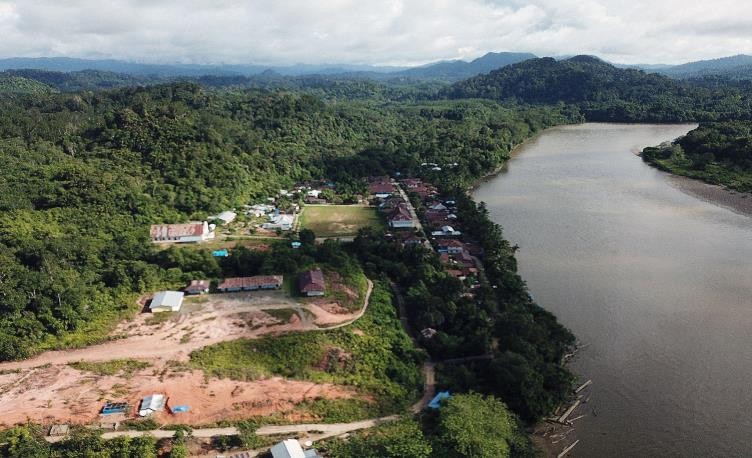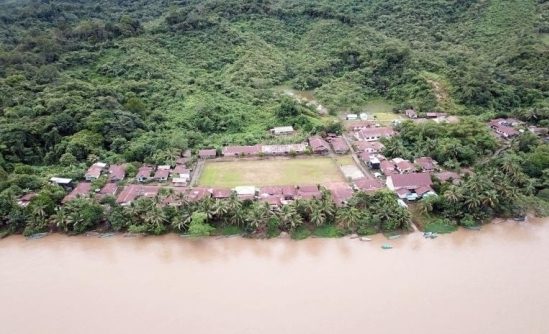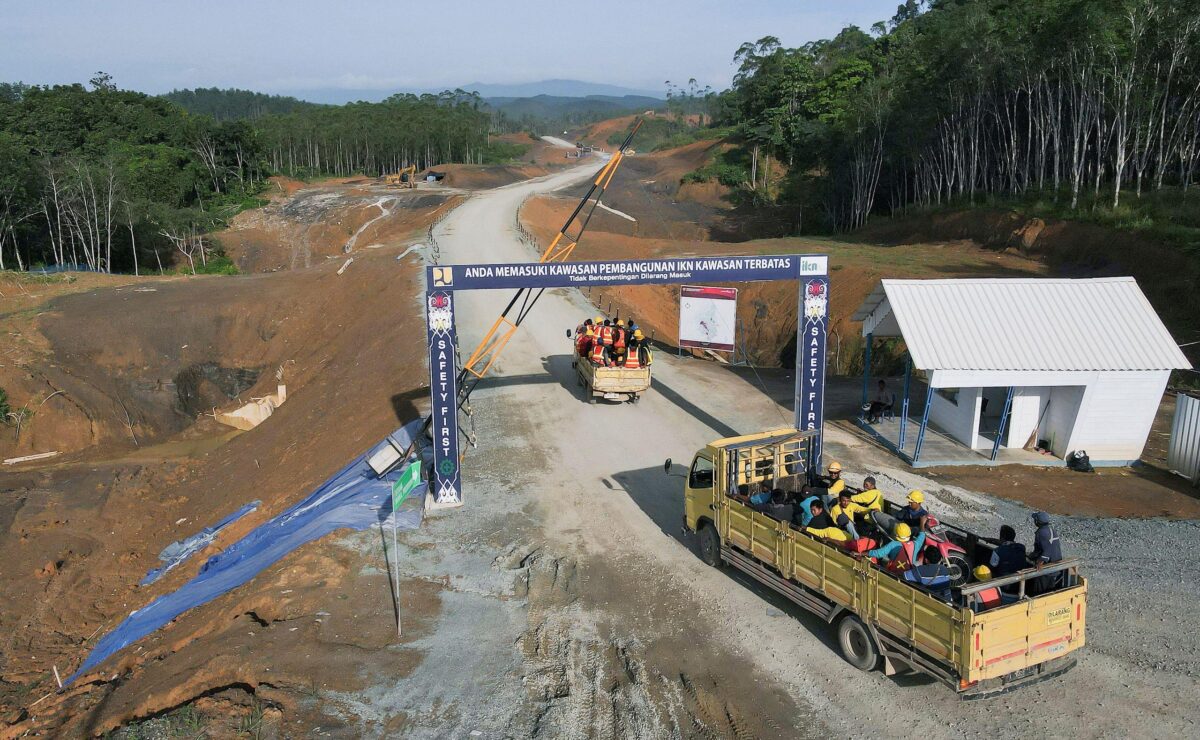A dam with Chinese backing is slowly being built, but may impact Indigenous villages and the environment, Yovanda Isabella writes.
Construction is pushing ahead on a series of Chinese-backed dams that are set to form Southeast Asia’s largest hydroelectric project, and which will power Indonesia’s new capital city, Nusantara.
But as work proceeds on the Kayan Cascade project – located in the North Kalimantan province of Borneo Island – controversies remain over permits and potential displacement of nearby communities.
In 2019, Indonesian president Joko “Jokowi” Widodo officially announced the location for the new capital, in Borneo’s East Kalimantan province. Work has since begun on building Nusantara, a task seen as urgent by his administration, given the issues that beset the current capital.
Jakarta is located on the western island of Java and is home to over 10 million people. It has frequently been ranked among the world’s most congested cities, is regularly struck by flooding, and faces increasing threats from sea level rise and subsidence.
President Jokowi has said the new capital will also begin to address the economic gap between Java and the other islands in Indonesia. Java accounts for 56% of the country’s population and 58% of its GDP. In contrast, the Kalimantan region is home to only 6% of the population and contributes 9.2% of GDP.
Nusantara is set to be inaugurated as the new capital in summer 2024, to coincide with Indonesian Independence Day on 17 August. The target is for the move to start after the country’s elections in February, with government offices and institutions continuing to relocate throughout the year.
But the planned city and accompanying infrastructure have not been free of controversy. In a statement in October 2022, Jokowi claimed that 80% of Nusantara’s energy will come from renewable sources – including solar, wind, and hydropower from the Kayan Cascade.
Amid this ambitious target, civil society groups and local communities are still seeking clarity and assurances over the environmental impacts and displacements that the Kayan project could cause.
The Kayan Cascade and power push
The Indonesian government is under increasing pressure to meet its climate pledges and mitigate the environmental issues that have regularly accompanied its development initiatives. These have included clearing of forests for settlements and roads, and pollution caused by their construction. As plans for Nusantara take shape, it has sought to answer these concerns with reforestation programs and the 80% renewable energy supply target.
In its 2021–2030 Electricity Supply Business Plan, Indonesia’s state electricity company PLN says it will begin supplying electricity to the new capital in 2024. Across the nation as a whole, it says it will then almost triple supply in the following three years, from a projected 382 gigawatt hours (GWh) in 2024 to 1,017 GWh in 2027.
The plan also includes the building of underground distribution networks and plans to prioritize new and renewable energy sources, targeting 20.9 GW of additional renewable capacity by 2030, which would bring its share of total capacity to 51.6%.
The Kayan hydropower plant is included in the plan. Developed by Kayan Hydro Energy (KHE), a company affiliated to Chinese state-owned enterprise PowerChina, the US$17 billion project is designed to consist of five dams with a total capacity of 9 gigawatts. On completion it could become the largest hydroelectric power plant in Southeast Asia.
For the environment, the threat is clear due to disruption of the hydrological function of the Kayan River and its tributaries, both in terms of ecosystems, biodiversity, loss of forest wetlands, agriculture, and fisheries both upstream and downstream of the river that cannot be restored.
Yohana Tiko, director of the East Kalimantan chapter of the Indonesian Forum for the Environment (WALHI)
PowerChina signed an agreement with KHE in 2018 to develop the project, which is located in the Peso district of North Kalimantan. The Chinese company had reportedly begun to study the Kayan River as far back as 2008, and completed the planning, feasibility study and preliminary design of Kayan River I Hydro Power Plant in 2013. Upon agreement, it was launched under the banner of the Belt and Road Initiative, China’s global infrastructure development strategy.
The Kayan Cascade plant will supply electricity to the provinces of South, Central, East, and North Kalimantan, including the city of Nusantara, some 400 km south of the facility. Khaerony, director of operations for KHE, said it will also distribute to industrial zones such as the planned Kalimantan Green Industrial Park in North Kalimantan. Another mega-project launched under the Jokowi administration, the park is set to host a range of industries, including an electric vehicle battery plant, petrochemicals, iron and steel.
The construction of the first Kayan dam will begin this year with work on a diversion canal, Khaerony told China Dialogue, and is expected to be completed in 2027. A 12 km access road to the planned dam is also currently under construction.
The director said that the Kayan hydro plant will make a sizeable contribution to the region in terms of electricity supply and income. However, its development and reception in the region has thus far been rocky. The dam’s construction has been hampered by delays and a slow permitting process, while it has generated disputes with Indigenous people in surrounding Peso district over compensation for displacement due to the project.
Potential impacts on Indigenous people and the environment
The Kayan project will directly affect at least two villages in Peso, a remote rural area through which the Kayan River flows. Initially, promises had been made by KHE to residents of Long Lejuh, a village of 414 people, and Long Pelban, home to 261. The villagers, who are Dayak Kenyah Indigenous peoples, were told they would be relocated and that a new residential area would be built like a small town. However, they say there has been no further discussion.
Santoso, the head of Long Pelban, said that KHE promised to relocate the two villages to these areas, each with an area of 600 hectares and in a predetermined location. He explained that these were to include residential areas, as well as agricultural land and community plantations. “But, so far all of that is like a dream,” Santoso said, adding that the plan has been discussed since 2012.
“It’s been 11 years, until now the price [that the company will pay for their lands] has not been discussed. Like it or not, we have to move. We are also confused about how to continue, because it has not been clear how KHE will proceed,” Santoso said.
The village head raised a number of concerns: “We were promised a new town would be built. We wondered whether it would be more prosperous. What is the model of residence? We are afraid that it will be more difficult in the future. Moreover, as farmers and cultivators, the new land must be more fertile.”


Yohana Tiko, director of the East Kalimantan chapter of the Indonesian Forum for the Environment (WALHI), said the construction of the hydropower mega-project would also have significant negative effects on the environment, affecting the survival of local communities up-and downstream.
“For the environment, the threat is clear due to disruption of the hydrological function of the Kayan River and its tributaries, both in terms of ecosystems, biodiversity, loss of forest wetlands, agriculture, and fisheries both upstream and downstream of the river that cannot be restored,” Tiko said.
Doni Tatiana of the Yayasan Pionir (Pioneer Foundation), a local development organisation based in North Kalimantan, told China Dialogue that while only Long Lejuh and Long Pelban will be submerged by the dam’s reservoir, the project’s environmental impact assessment, known as an AMDAL, also includes impacts on a further four villages. These include less severe inundations of land and impacts on sites of ancestral heritage and cultural significance.
Tiko commented that she is concerned at the potential for coercion in the relocation and compensation process. “In the transfer, it is not impossible that it will be carried out by force,” she said, adding that the relocations are “the sacrificing of the community”, after which “the area will lose its cultural identity and customs”.
Tatiana raised similar concerns, with doubts over whether residents’ right to free, prior and informed consent has been respected, questioning the quality and clarity of communication with the company and authorities.
According to Tiko, after obtaining a new area, relocated people may not end up with a decent place to live. She echoed Santoso’s concerns over villagers being moved to less fertile land, or even causing tensions in the area to be occupied. “There are fears that the new land will not be productive and has the potential for conflict with other local communities,” she said.
When asked about relations with the residents of Long Lejuh and Long Pelban, Khaerony claimed that “there is no conflict”. “We have always accommodated villagers and our relationships with the locals are very good,” he said. He provided no further information on the relocation process and negotiations.
This article was originally published on China Dialogue on 6 April 2023 under the Creative Commons BY NC ND licence.
